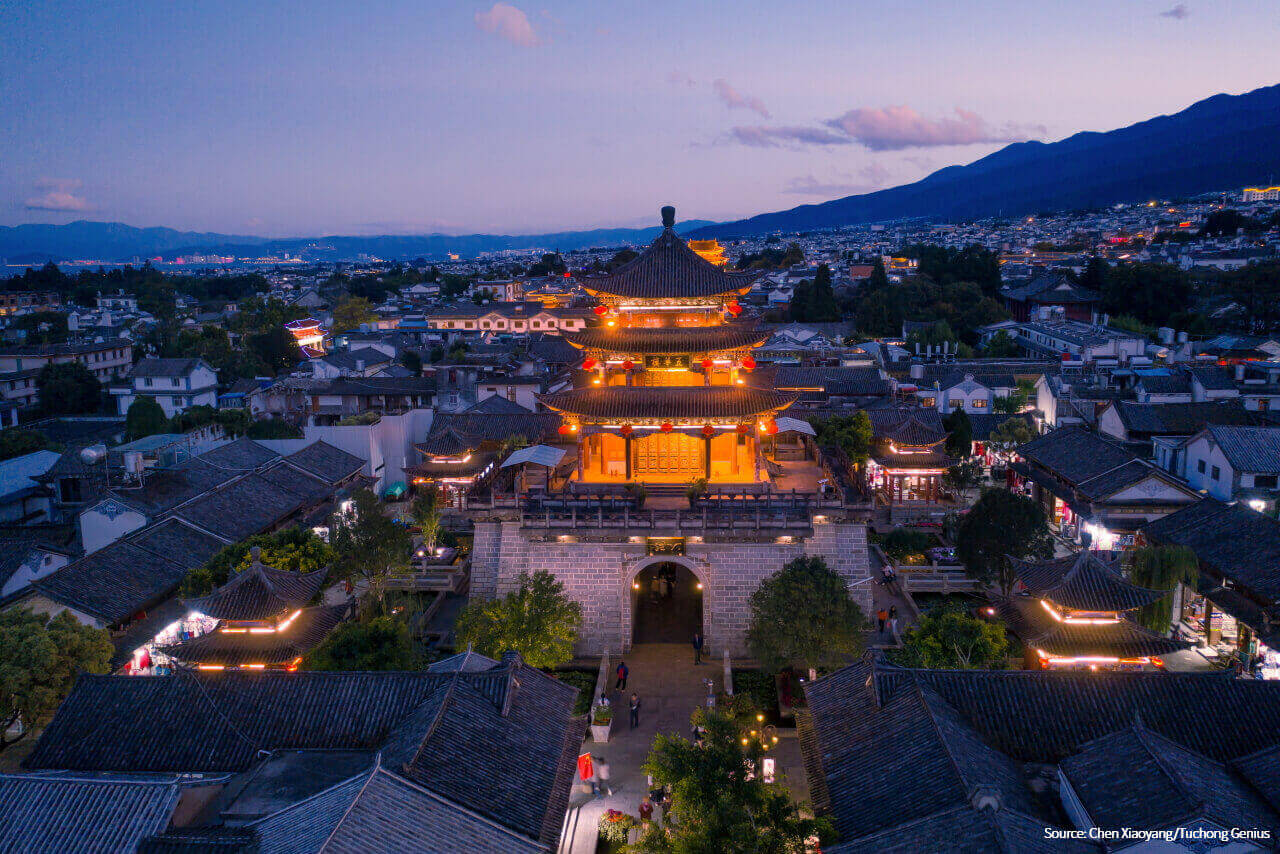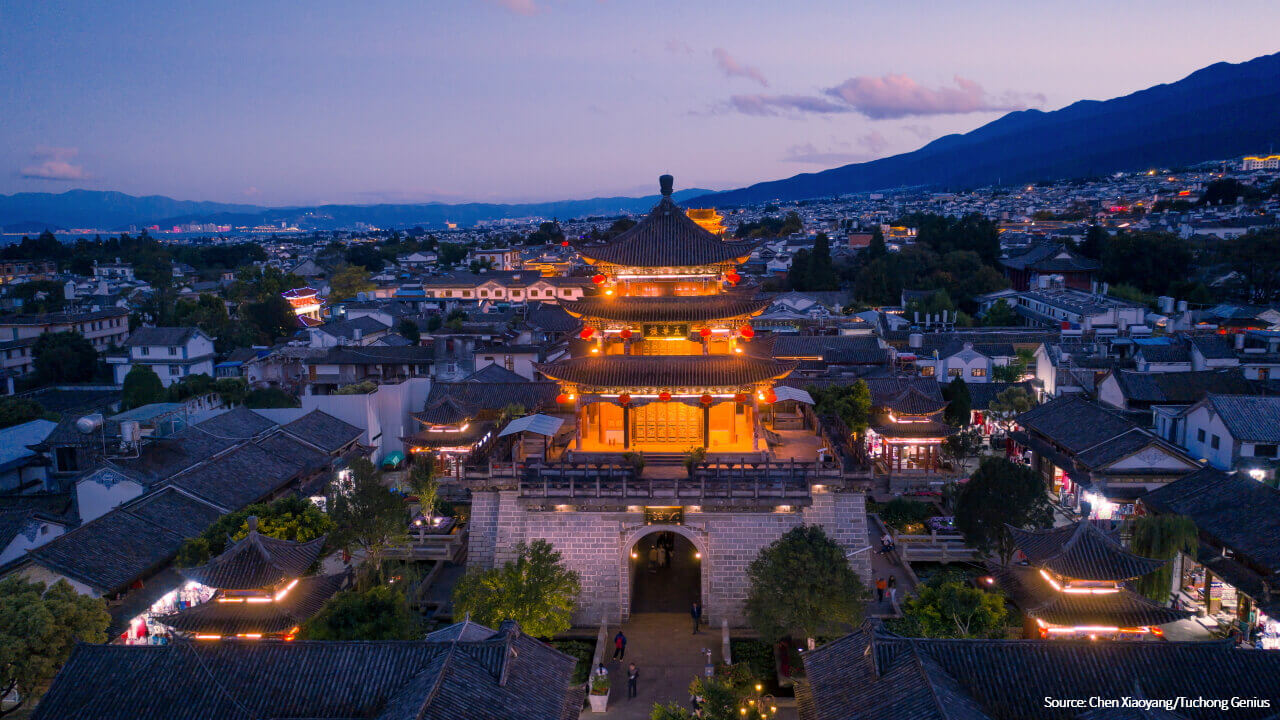
Dali Ancient Town

Name in Chinese: 大理古城 Dà Lǐ Gǔ Chéng [da: li: gu: tsen]
Duration of Tour: Two or Three Hours
Location: No.42, Yita Road, Dali, Yunnan Province, China
Highlights: the Ancient Chinese Architecture and the Bai People’s Traditional Culture
Must-see Sightseeing Spots: Wenxian Pavilion, Wuhua Pavilion and Cheng’en Gate Tower
Reputations: One of China’s Most Attractive Old Towns, a Four-star Scenic Area
Dali Ancient Town is one of the must-see attractions in Yunnan Province. The town was founded by Geluofeng(712-779), the second ruler of the Ancient Nanzhao Kingdom(738-902). Geluofeng succeeded to the throne in 748. He led his people to build his palace in Dali. Then, Dali became the capital of the Ancient Nanzhao Kingdom. It was in the year of 937, Duan Siping(893-944) established the Ancient Dali Kingdom and made Dali the capital of his kingdom. The Ancient Dali Kingdom was conquered by Kublai Khan’s army in 1253. The town was damaged due to the war. It was rebuilt in the year of 1382, when the Ming’s army occupied Yunnan. Since then, the town has become the seat of government of Dali Prefecture. Most of the present buildings in the old town can be dated back to the Ming Dynasty(1368-1644).
The old town measures about 300 hectares(741 acres). It is situated on the western shore of Erhai Lake. Cangshan Mountain stands sheer above both the town and the lake. The town is enclosed by ramparts which are 7.5 meters(25 feet) high and 6 meters(20 feet) thick. The total length of the ramparts is about 6 kilometers(3.7 miles). There are four gate towers along the ramparts. The gate towers each are magnificent. The town is divided into over 20 blocks by 3 main streets parallel with the meridian and 6 lanes parallel with the equator. Each of the houses shows the ancient Chinese architecture.
The main inhabitants of the town are the Han and the Bai peoples. The Bai people maintain a strong cultural tradition. Bai means white in English. The white is the favorite color of the Bai people. However, they often dress themselves in various colors. The traditional costume of the Bai is quite different from that of the Han. Their eating and drinking habits are also absolutely unique. The Three-Course Tea is their favourite traditional drink. It is an absolutely unique method of drinking tea.
Wenxian Pavilion
Wenxian Pavilion is a two-storey wooden and earthen building. It show the Bai’s traditional architecture. The pavilion was constructed during the reign of Emperor Kangxi(1654-1722) of the Qing Dynasty(1644-1911). Emperor Kangxi was on the throne from 1661 to 1722. There is an inscribed board hanging under the front eaves of the pavilion. The inscription is in Emperor Kangxi’s handwriting. It reads “Wen Xian Ming Bang”, meaning “a state which is noted for works of literature”.
Wuhua Pavilion
Wuhua Pavilion used to be a luxury guest house of the Ancient Nanzhao Kingdom which provided temporary accommodations for politicians and officials from the Tang Empire and some neighbouring vassals of the Tang. However, the building was burnt to the ground due to the war between the Ming’s army and the remnants of the Yuan’s force. It was rebuilt during the reign of Emperor Zhu Yuanzhang(1328-1398), the founder of the Ming Dynasty(1368-1644).
Cheng’en Gate Tower
Cheng’en Gate Tower is situated at the north gate of the town. It was constructed in the fifteenth year of Emperor Zhu Yuanzhang(1382). As a landmark of Dali, the tower is the oldest and most magnificent building in the town.
Anyuan Gate Tower
Anyuan Gate Tower serves as the north gate of the town. It was also built in the year of 1382. The name of the tower, “Anyuan” means to bring lasting peace to border regions. The tower is also called San-ta Gate, meaning “three pagodas”. The three pagodas are regarded as the symbol of Dali. The pagodas are located in the nearby Chongsheng Temple.
There are many places of interest in or near the old town. Some of the most attractive places are Erhai Lake, Chongsheng Temple, Xizhou Ancient Town, the Examination Compound in the Feudal China, Guan Yu’s Shrine and Confucius Temple.
Travel Tips:
How to Get to Dali Ancient Town
Dali Ancient Town is located in West Central Yunnan, about 350 kilometers(217 miles) to the northwest of Kunming, the capital city of Yunnan Province. Dali Huangcaoba Airport is located 13 kilometers(8 miles) to downtown Dali. It operates flights to some major cities within Mainland China, such as Beijing, Shanghai, Chengdu, Xi’an and Kunming. However, most of the tourists prefer to travel to Dali by car or bullet train from Kunming.
Weather
The tropical latitude of Dali means that tourists need to bring some suncream and sunhats when they travel to Dali. The temperature in Dali ranges from 6℃(42.8°F) to 19℃(66.2°F) in spring, 14℃(57.2°F) to 25℃(77°F) in summer, 17℃(62.6°F) to 25℃(77°F) in autumn, and 7℃(46.4°F) to 20℃(68°F) in winter. Both spring and autumn are the best time to travel to Dali. The spring comes in February and goes in April, while the autumn lasts from September to November.
Suggested Itineraries:
Related Articles:
Author: Tina Luo
Update:

Dali Ancient Town